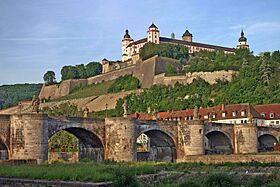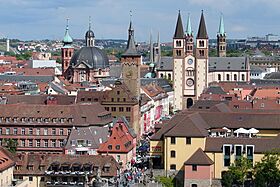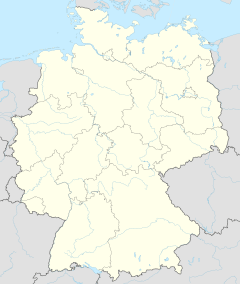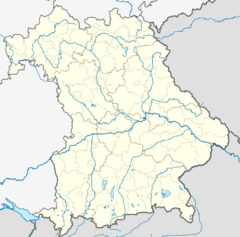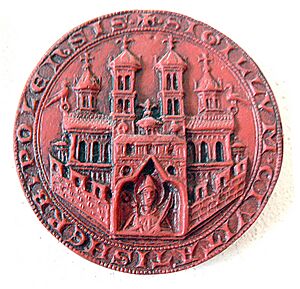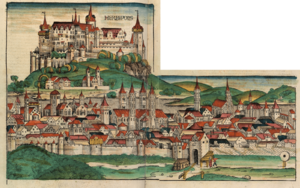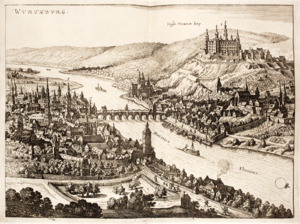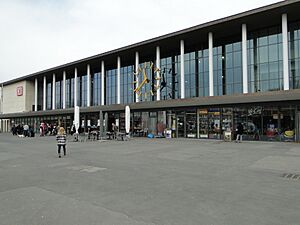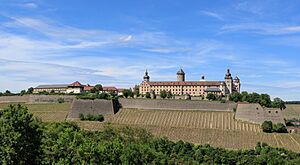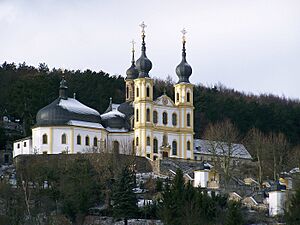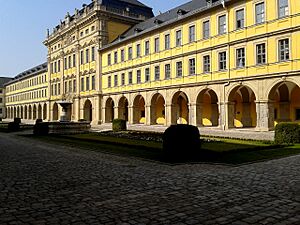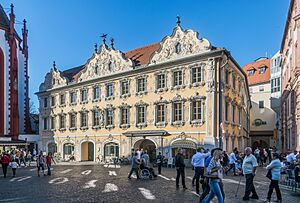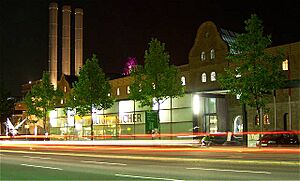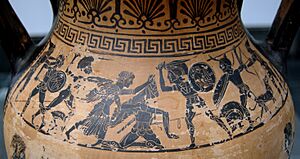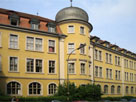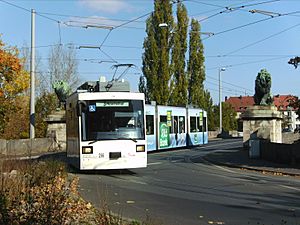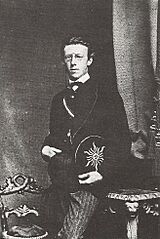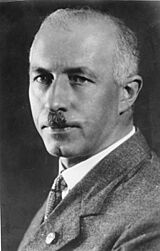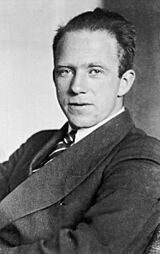Würzburg facts for kids
Quick facts for kids
Würzburg
Wörtzburch (Mainfränkisch)
|
|||
|---|---|---|---|
|
Clockwise from top: Marienberg Fortress and Old Bridge – the Main with a newer bridge – the Old Town with the cathedral, narrow square and city hall – and the Residence, a world heritage site.
|
|||
|
|||
| Country | Germany | ||
| State | Bavaria | ||
| Admin. region | Lower Franconia | ||
| District | Urban district | ||
| Area | |||
| • Total | 87.63 km2 (33.83 sq mi) | ||
| Elevation | 177 m (581 ft) | ||
| Population
(2022-12-31)
|
|||
| • Total | 127,810 | ||
| • Density | 1,458.52/km2 (3,777.5/sq mi) | ||
| Time zone | UTC+01:00 (CET) | ||
| • Summer (DST) | UTC+02:00 (CEST) | ||
| Postal codes |
97070–97084
|
||
| Dialling codes | 0931 | ||
| Vehicle registration | WÜ | ||
Würzburg is a city in Franconia, a region in northern Bavaria, Germany. It is the third-largest city in Franconia, after Nuremberg and Fürth. Würzburg is also the main city for the Regierungsbezirk of Lower Franconia. It is built on the banks of the Main river.
The city is about 110 kilometers (68 miles) west-northwest of Nuremberg and 120 kilometers (75 miles) east-southeast of Frankfurt am Main. In 2019, about 130,000 people lived in Würzburg.
Würzburg is well-known for its old town, which has been partly rebuilt after being damaged. It is also famous for the Würzburger Residenz, a palace that is a UNESCO World Heritage Site. This means it is a place of special cultural importance to the world.
People in Würzburg speak a local dialect called East Franconian German.
Contents
- A Look at Würzburg's History
- Würzburg's Geography
- People Living in Würzburg
- Würzburg's Climate
- Würzburg's Economy
- Arts and Culture in Würzburg
- Sports in Würzburg
- How Würzburg is Governed
- Education and Research
- Media in Würzburg
- Getting Around Würzburg
- City Services and Utilities
- Famous People from Würzburg
- Würzburg's Twin Towns
- Images for kids
- See also
A Look at Würzburg's History
Historical affiliations
Duchy of Franconia (to 1168)
![]() Prince-Bishopric of Würzburg, 1168–1803
Prince-Bishopric of Würzburg, 1168–1803
![]() Electorate of Bavaria, 1803–1805
Electorate of Bavaria, 1803–1805
![]() Grand Duchy of Würzburg, 1805–1814
Grand Duchy of Würzburg, 1805–1814
![]() Kingdom of Bavaria, 1814–1871
Kingdom of Bavaria, 1814–1871
![]() German Empire, (Kingdom of Bavaria), 1871–1918
German Empire, (Kingdom of Bavaria), 1871–1918
![]() German Reich, 1918–1919
German Reich, 1918–1919
![]() Würzburg Soviet Republic, 1919
Würzburg Soviet Republic, 1919
![]() German Reich, 1919–1945
German Reich, 1919–1945
![]() American-occupied zone, 1945–1949
American-occupied zone, 1945–1949
![]() Germany, 1949–present
Germany, 1949–present
Early and Medieval Times
Long ago, during the Bronze Age, there was a refuge castle on a hill where Fortress Marienberg now stands. This castle was first built by the Celts. Later, the Romans also used it as a fort.
In the 4th or 5th century, the Alamanni people settled here, followed by the Franks in the 6th and 7th centuries. Würzburg became the home of a duke around 650. In 686, Irish missionaries like Kilian brought Christianity to the city.
Würzburg is mentioned in old writings from 704. Its name likely comes from a Celtic word. However, people later connected it to the German word Würze, meaning "herb" or "spice." This led to the Latin name Herbipolis in the Middle Ages.
The first bishop of Würzburg, Saint Burkhard, was appointed in 742 by Saint Boniface. Over time, the bishops gained control of the land, creating a large area in Eastern Franconia.
Würzburg was also the location of important meetings called Imperial Diets. In 1180, for example, Henry the Lion, a powerful duke, was banned from the Empire here. Sadly, there were also attacks on Jewish people in 1147 and 1298.
The first church on the site of the current Würzburg Cathedral was built in 788. The impressive building you see today was constructed between 1040 and 1225 in the Romanesque style.
The University of Würzburg was first started in 1402. It was then re-established in 1582 by Julius Echter von Mespelbrunn. The people of Würzburg often tried to gain more freedom from the prince-bishop. In 1397, King Wenceslaus IV of Bohemia even promised them the status of a free Imperial City. But this promise was later taken back.
In 1400, the bishop's army defeated the citizens, and the city remained under his control. During the German Peasants' War in 1525, a local council member, Tilman Riemenschneider, refused to fight the revolting peasants. This led to a battle where many peasants lost their lives just outside Würzburg. Riemenschneider and the entire town council were put in prison.
Modern History of Würzburg
The Würzburg witch trials happened between 1626 and 1631. During this time, many people were accused of being witches and sadly, lost their lives. In 1631, the Swedish King Gustaf Adolf invaded, and the witch trials ended.
Construction of the Würzburg Residence palace began in 1720. In 1796, the Battle of Würzburg took place between Austrian and French forces.
In 1803, the city became part of Bavaria. A few years later, during the Napoleonic Wars, it became the capital of the Grand Duchy of Würzburg. In 1814, Würzburg joined the Kingdom of Bavaria. A new bishopric was created in 1821.
In 1817, Friedrich Koenig and Andreas Bauer started the world's first company to make steam-powered printing presses in Würzburg.
The Hep-Hep riots in 1819 were sad events where Jewish people were attacked and their property damaged.
In 1848, Catholic bishops held an important meeting in Würzburg, which was a step towards later German and Austrian conferences. In 1866, Würzburg was attacked by the Prussians and stopped being a fortress.
In the early 1930s, about 2,000 Jewish people lived in Würzburg. When the Nazi Party took control in 1933, things changed for the worse. During the Kristallnacht in 1938, Jewish homes and shops were attacked, and many Jewish people were sadly sent away to camps.
From 1943 to 1945, a small camp for prisoners was located in the city. Most of these prisoners were from Poland and the Soviet Union.
World War II Bombing
On March 16, 1945, during World War II, about 90% of Würzburg was destroyed in just 17 minutes. This happened during an air raid by 225 British Lancaster bombers. Würzburg was targeted because it was an important transport hub.
Most of the city's churches, cathedrals, and other famous buildings were badly damaged or completely destroyed. The city center, which was very old, was ruined in a huge fire. Many people lost their lives.
Over the next 20 years, the important historical buildings were carefully rebuilt exactly as they were before. The people who rebuilt the city right after the war were mostly women, known as Trümmerfrauen ("rubble women"). This was because many men had died or were still prisoners of war.
Würzburg was destroyed even more than Dresden was a month earlier. Today, the old town is considered a cultural heritage site because of all the rebuilding and reconstruction.
Battle of Würzburg (1945)
On April 3, 1945, American troops from the 12th Armored Division and the 42nd Infantry Division took control of Würzburg. The battle continued until April 5, 1945, when the last German resistance ended.
Würzburg's Geography


Würzburg is located on the banks of the Main river in the region of Lower Franconia, Bavaria. The main part of the city is on the right bank of the river. The city is surrounded by the Landkreis Würzburg (Würzburg district), but it is not part of it.
The city covers an area of 87.6 square kilometers (33.8 square miles) and is about 177 meters (581 feet) above sea level.
In 2007, about 30% of the city's land was used for buildings. Agricultural land made up 27.9%, forests 15.5%, and green spaces 12.7%.
The center of Würzburg is surrounded by hills. To the west is the 266-meter (873-foot) Marienberg, and to the south is the Nikolausberg (359 meters or 1,178 feet). The Main river flows through Würzburg from the southeast to the northwest.
How the City is Organized
Würzburg is divided into 13 main areas called Stadtbezirke. These areas are then split into 25 smaller parts called boroughs. Here's a list of these boroughs:
|
01 Altstadt
|
02 Zellerau
03 Dürrbachtal
04 Grombühl
05 Lindleinsmühle
|
06 Frauenland
07 Sanderau
08 Heidingsfeld
09 Heuchelhof
|
10 Steinbachtal
11 Versbach
12 Lengfeld
13 Rottenbauer
|
People Living in Würzburg
Würzburg's population in 2023 is estimated to be about 126,033 people.
People from Other Countries
Würzburg is home to people from many different countries. Here are the largest groups of foreign residents as of December 2022:
| Largest groups of foreign residents: | |
| Nationality | Population (Dec. 2022) |
|---|---|
| 1,632 | |
| 1,316 | |
| 1,153 | |
| 1,086 | |
| 759 | |
| 603 | |
| 588 | |
| 526 | |
| 483 | |
| 414 | |
| 🦘 Australia | 1 |
Würzburg's Climate
| Climate data for Würzburg (1991–2020 normals) | |||||||||||||
|---|---|---|---|---|---|---|---|---|---|---|---|---|---|
| Month | Jan | Feb | Mar | Apr | May | Jun | Jul | Aug | Sep | Oct | Nov | Dec | Year |
| Mean daily maximum °C (°F) | 3.8 (38.8) |
5.6 (42.1) |
10.4 (50.7) |
15.8 (60.4) |
19.9 (67.8) |
23.3 (73.9) |
25.5 (77.9) |
25.4 (77.7) |
20.4 (68.7) |
14.3 (57.7) |
8.0 (46.4) |
4.5 (40.1) |
14.7 (58.5) |
| Daily mean °C (°F) | 1.2 (34.2) |
2.0 (35.6) |
5.8 (42.4) |
10.3 (50.5) |
14.4 (57.9) |
17.8 (64.0) |
19.7 (67.5) |
19.3 (66.7) |
14.8 (58.6) |
9.9 (49.8) |
5.0 (41.0) |
2.0 (35.6) |
10.2 (50.4) |
| Mean daily minimum °C (°F) | −1.4 (29.5) |
−1.2 (29.8) |
1.6 (34.9) |
4.9 (40.8) |
8.9 (48.0) |
12.3 (54.1) |
14.1 (57.4) |
13.8 (56.8) |
10.0 (50.0) |
6.2 (43.2) |
2.4 (36.3) |
−0.4 (31.3) |
5.9 (42.6) |
| Average precipitation mm (inches) | 40.0 (1.57) |
35.8 (1.41) |
40.2 (1.58) |
32.7 (1.29) |
57.3 (2.26) |
52.9 (2.08) |
65.8 (2.59) |
56.3 (2.22) |
47.2 (1.86) |
47.6 (1.87) |
46.2 (1.82) |
51.5 (2.03) |
573.5 (22.58) |
| Average precipitation days (≥ 1.0 mm) | 14.9 | 13.8 | 14.1 | 12.2 | 13.0 | 13.3 | 14.0 | 12.4 | 12.0 | 14.6 | 14.3 | 17.2 | 165.8 |
| Average snowy days (≥ 1.0 cm) | 8.2 | 4.2 | 1.8 | 0 | 0 | 0 | 0 | 0 | 0 | 0 | 1.0 | 4.6 | 19.8 |
| Average relative humidity (%) | 84.7 | 80.5 | 73.6 | 66.2 | 68.4 | 68.5 | 67.7 | 68.8 | 76.0 | 83.6 | 87.8 | 87.8 | 76.1 |
| Mean monthly sunshine hours | 54.8 | 84.4 | 132.3 | 190.7 | 215.4 | 223.9 | 237.1 | 226.2 | 166.7 | 106.7 | 51.5 | 42.7 | 1,724.9 |
| Source: World Meteorological Organization | |||||||||||||
Würzburg's Economy
Würzburg is mainly known as a center for administration. The biggest employers are the Julius-Maximilians-University and the city government itself. Among private companies, Brose Fahrzeugteile and Koenig & Bauer, which makes printing machines, are the largest.
Würzburg is also the capital of the Franconian wine region. This area is famous for its dry white wines, especially those made from the Silvaner grape. The Würzburger Hofbräu brewery also makes a well-known local pilsner beer.
Did you know Würzburg has the oldest pizzeria in Germany? Nick di Camillo opened his restaurant, Bier- und Speisewirtschaft Capri, on March 24, 1952. He even received an honor from Italy for this!
In 2017, the city's GDP per person was €62,229. This placed Würzburg as one of the top districts in Bavaria for economic output.
Military Presence in Würzburg
After World War II, the U.S. Army had troops stationed in Würzburg. The last U.S. troops left in 2008, ending over 60 years of their presence in the city.
Arts and Culture in Würzburg
Many famous artists have lived in Würzburg. These include the poet Walther von der Vogelweide and the sculptor Tilman Riemenschneider. Riemenschneider was even a mayor and took part in the German Peasants' War. The famous composer Richard Wagner worked here as a chorus master in 1833 and finished his first opera, Die Feen, in Würzburg.
Some of the city's "100 churches" survived the war. They show different styles of architecture, from Romanesque (Würzburg Cathedral) to Gothic (Marienkapelle), Renaissance (Neubaukirche), and Baroque (Stift Haug Kirche).
Major festivals in Würzburg include the Africa Festival in May, the Mozart Festival in June/July, and the Kiliani Volksfest in mid-July.
Main Sights to See
- Würzburger Residenz: This huge palace is a UNESCO World Heritage Site. It was built between 1720 and 1744 for two prince-bishops. Many architects worked on it, but it's mostly known for Balthasar Neumann, who designed its famous Baroque staircase. The palace was badly damaged in 1945 but has been completely rebuilt.
- Hofkirche: This church inside the Residence is beautifully decorated with paintings and sculptures. The altars were painted by Giovanni Battista Tiepolo.
- Treppenhaus: Here, Giovanni Battista Tiepolo created the largest fresco (wall painting) in the world. It covers the ceiling above the grand staircase.
- Kaisersaal: The "Imperial Hall" is the main room of the palace. It shows the strong connection between Würzburg and the Holy Roman Empire.
- Festung Marienberg: This fortress sits on Marienberg hill, west of the city center. It offers amazing views of Würzburg. Most of its current buildings are from the Renaissance and Baroque periods, but its chapel dates back to the 8th century.
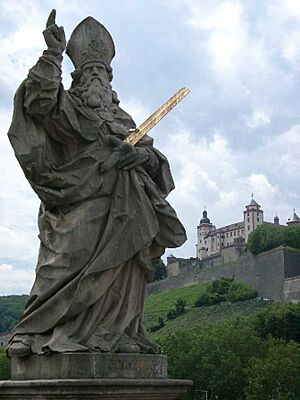
- Alte Mainbrücke (Old Main Bridge): This bridge was built between 1473 and 1543. From 1730, it was decorated with twelve large statues of saints and important historical figures like Charlemagne. The bridge was damaged in World War II.
- Rathaus (City Hall): Würzburg's city hall is a mix of different buildings and wings. This is because after 1426, the city was controlled by the bishop, who didn't allow a grand new building. Parts of the Rathaus date back to 1339.
- Churches of Würzburg:
- Käppele: A small, beautiful Baroque/Rococo chapel designed by Balthasar Neumann, located on a hill facing the fortress.
- Dom (Würzburg Cathedral): The main cathedral. Its Baroque Schönbornkapelle chapel has unique decorations. Inside the cathedral, you can see two famous works by Tilman Riemenschneider: the tombstones of Rudolf II von Scherenberg and Lorenz von Bibra.
- Marienkapelle: Located on the market square, built between 1377 and 1441. It has copies of Riemenschneider's statues of Adam and Eve.
- Neumünster: A Romanesque church from the 11th century with a Baroque front. Its crypt holds the relics of saints Kilian, Totnan, and Kolonat.
- Lusamgärtchen: Next to the Neumünster, this garden has a memorial to the poet Walther von der Vogelweide, who was likely buried here in 1230.
- St. Burchard's Abbey, Würzburg|St Burchard's Abbey: The church of the town's oldest abbey, founded around 750.
- Other Baroque churches: Stift Haug, St. Michael, St. Stephan, and St. Peter.
- Juliusspital: A Baroque hospital with a courtyard and a church, founded in 1576. It has a 160-meter-long (525-foot) northern wing and a huge wine cellar underneath. The Juliusspital is the second-largest winery in Germany.
- Haus zum Falken: Located on Marktplatz, this building has a fancy stucco front from the Rococo period. It used to be an inn and now houses a public library and tourist information.
- Stift Haug: Built between 1670 and 1691, this was the first Baroque church in Franconia. It was designed by Antonio Petrini.
- Würzburger Stein: Just outside the city, this is one of Germany's oldest and largest vineyards.
Museums and Art Galleries
- Museum für Franken: Located in the fortress, this museum has the world's largest collection of works by Tilman Riemenschneider. It also shows art from regional artists, a pre-historic collection, and items about Franconian wine culture.
- Fürstenbaumuseum: Also in the fortress, this museum shows the restored living areas of the prince-bishops. It also has exhibits on Würzburg's history, gold jewelry, and models of the city from 1525 and 1945.
- Museum im Kulturspeicher: Housed in an old grain storage building mixed with modern design. It has over 3,500 square meters (37,674 square feet) of exhibit space. Collections include European Concrete art, works from the Romantic Age, and contemporary art.
- Museum am Dom: Opened in 2003, this museum near the cathedral displays about 700 pieces of art from the last 1,000 years. It shows how contemporary art connects with older works.
- Shalom Europe: A Jewish museum built around 1,504 old tombstones found in the city. It uses modern technology to show Jewish life and history in Würzburg over the past 900 years.
- Martin von Wagner Museum: Located in the Residence, this museum has objects from ancient Egypt, Greece, and Rome. It also features art from the 14th to the 19th centuries.
- Siebold-Museum: This museum has exhibits about the 19th-century local doctor and Japan researcher Philipp Franz von Siebold.
- Röntgen Memorial Site: This site is dedicated to the physicist Wilhelm Conrad Röntgen, who discovered X-rays in Würzburg in 1895. It has historical instruments and documents.
Sports in Würzburg
Famous NBA basketball player Dirk Nowitzki was born and grew up in Würzburg. He and many other German national team players started their careers at the local Baskets Würzburg club. This club plays in Germany's top basketball league.
Würzburg also has football teams, Würzburger Kickers and Würzburger FV, who play in the Fußball-Bayernliga.
SV Würzburg 05 is a swimming and water polo club that competes in the German Water Polo League.
How Würzburg is Governed
Würzburg is the main administrative city for the region of Lower Franconia. The administration for the Landkreis Würzburg (Würzburg district) is also located here.
Since April 2014, the mayor of Würzburg has been Christian Schuchardt. He is a member of the CSU party.
Education and Research
Würzburg has several well-known places for science and research.
University of Würzburg
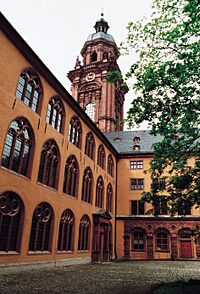
The University of Würzburg (officially Julius-Maximilians-Universität Würzburg) was founded in 1402. It is one of the oldest universities in Germany.
Students can study many subjects here, including astronomy, biology, chemistry, computer science, law, medicine, physics, and psychology.
Today, the university's ten different departments are spread across the city. About 29,000 students attend the university, with over 1,000 coming from other countries.
- Wilhelm Röntgen's original laboratory, where he discovered X-rays in 1895, is at the University of Würzburg.
- The university gave Alexander Graham Bell an honorary degree for his important scientific work.
- The Botanischer Garten der Universität Würzburg is the university's own botanical garden.
University of Applied Sciences
The University of Applied Sciences Würzburg-Schweinfurt was started in 1971. It has departments in both Würzburg and Schweinfurt. Students can study subjects like architecture, business economics, civil engineering, computer science, electrical engineering, graphic design, and social work. With almost 8,000 students, it is the second-largest university of applied science in Franconia.
Conservatory of Music
The Conservatory of Würzburg has a long and successful history of over 200 years. It was founded in 1797 and is Germany's oldest conservatory. Today, it is known as the University of Music Würzburg. In the 1970s, it also started offering science and research alongside music education.
Media in Würzburg
Würzburg has its own daily newspaper called Main-Post. Radio stations like Antenne Bayern and the state broadcaster Bayerischer Rundfunk have local studios here. The latter also has a large broadcasting station and a TV studio in the city.
Getting Around Würzburg
Roads
Würzburg is an important traffic hub because of its central location. Major Autobahn highways meet here, including A3 (connecting to Cologne, Frankfurt, and Nuremberg) and A7 (connecting to Hamburg, Hanover, and Ulm). The A81 also starts here, going towards Stuttgart. Several other main roads also pass through the city.
Rail Travel
The city's main train station is a key point for both long-distance and local train services. Würzburg is at the southern end of the Hanover-Würzburg high-speed rail line. This means there are frequent fast train connections to cities like Cologne, Frankfurt, Hanover, Hamburg, Munich, Nuremberg, and Vienna. Besides the main station, there are two smaller local stations.
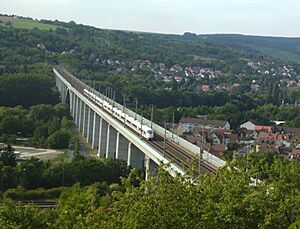
| Long distance | Route | |
|---|---|---|
| ICE (Linie 25) |
Munich – Nuremberg – Würzburg – Kassel – Hanover – Hamburg | |
| Munich – Augsburg – Würzburg – Kassel – Hanover – Hamburg / – Bremen | ||
| ICE (Linie 31) |
Vienna – Linz – Passau – Nuremberg – Würzburg – Frankfurt (Main) – Mainz – Koblenz – Cologne – Wuppertal – Hagen – Dortmund | |
| ICE (Linie 41) |
Munich – Nuremberg – Würzburg – Frankfurt (Main) – Cologne – Düsseldorf – Essen | |
| regional | Route | |
|---|---|---|
| Regional-Express | Würzburg – Kitzingen – Neustadt (Aisch) – Fürth – Nuremberg | |
| Regional-Express | Würzburg – Aschaffenburg – Hanau – Frankfurt (Main) | |
| Regional-Express | Würzburg – Osterburken – Heilbronn – Ludwigsburg – Stuttgart | |
| Regional-Express | Würzburg – Schweinfurt – Bamberg – Lichtenfels – Hof/–Bayreuth | |
| Regional-Express | Würzburg – Bamberg – Erlangen – Fürth – Nuremberg | |
| Regional-Express | Würzburg – Schweinfurt – Bad Kissingen / – Münnerstadt – Bad Neustadt – Mellrichstadt – Meiningen – Suhl – Arnstadt – Erfurt | |
| Regional train | Schlüchtern – Jossa – Gemünden (Main) – Würzburg – Schweinfurt – Bamberg | |
| Regional train | Karlstadt – Würzburg– Steinach – Ansbach – Treuchtlingen | |
| Regional train | Würzburg – Kitzingen | |
| Regional train | Würzburg – Bad Mergentheim – Weikersheim – Crailsheim | |
Trams in Würzburg
Würzburg has a tram network with five lines, covering about 19.7 kilometers (12.2 miles).
| Line | Route | Time | Stops |
|---|---|---|---|
| 1 | Grombühl – Sanderau | 20 minutes | 20 |
| 2 | Hauptbahnhof (Main station) – Zellerau | 14 minutes | 11 |
| 3 | Hauptbahnhof (Main Station) – Heuchelhof | 27 minutes | 20 |
| 4 | Sanderau – Zellerau | 23 min. | 18 |
| 5 | Grombühl – Rottenbauer | 39 minutes | 31 |
A new tram line, Line 6, is planned to connect the main station to the Hubland university campus.
Buses in Würzburg

There are 27 bus lines that connect different parts of the city and its nearby areas. Another 25 bus lines link the Landkreis Würzburg (the surrounding district) to the city.
Port on the Main River
The Main river flows into the Rhine river. It is also connected to the Danube river through the Rhine-Main-Danube Canal. This creates a large waterway across Europe, linking the North Sea to the Black Sea.
Bicycle Paths
Würzburg has special paths for bicycles throughout the city. The long-distance Main-Radweg bicycle trail also goes through the old town.
City Services and Utilities
Utilities
The local public utility company, Würzburger Versorgungs- und Verkehrs-GmbH, provides electricity, natural gas, and water. It also manages public transportation and parking. This company also owns most of the city's port and handles garbage collection and recycling.
Famous People from Würzburg
- Joseph Friedrich Abert (1879–1959), a historian and archivist.
- Heinrich Albert (1870–1950), a classical guitarist and composer.
- Yehuda Amichai (1924–2000), an Israeli poet.
- Thomas Bach (born 1953), an Olympic gold medalist in fencing and current President of the IOC.
- Frank Baumann (born 1975), a footballer.
- Fritz Bayerlein (1899–1970), a World War II general.
- Lorenz von Bibra (1459–1519), a Prince-Bishop of Würzburg.
- Mark Bloch (born 1956), an American artist.
- Theodor Boveri (1862–1915), a biologist.
- Christian von Ditfurth (born 1953), a writer and historian.
- Jutta Ditfurth (born 1951), a sociologist, writer, and historian.
- Brendan Donovan (born 1997), a baseball player.
- Freimut Duve (1936–2020), a politician and author.
- Björn Emmerling (born 1975), a field hockey player.
- Gottfried Feder (1883–1941), an economist and politician.
- Leonhard Frank (1882–1961), an expressionist writer.
- Manfred H. Grieb (1933–2012), an entrepreneur and art collector.
- Duane Harden (born 1971), a dance music singer.
- Werner Heisenberg (1901–1976), a theoretical physicist.
- Alfred Jodl (1890–1946), a World War II general.
- Wilhelm Keilmann (1908–1999), a composer.
- Friederich von Kleudgen (1856–1924), a painter.
- Maximilian Kleber (born 1992), a basketball player.
- Joseph Küffner (1776–1856), a composer.
- Luitpold, Prince Regent of Bavaria (1821–1912).
- Ernst Mayr (1904–2005), an evolutionary biologist.
- Waltraud Meier (born 1956), an opera singer.
- Julius Echter von Mespelbrunn (1545–1617), a Prince-Bishop of Würzburg.
- Johann Balthasar Neumann (1687–1753), a famous architect.
- Dirk Nowitzki (born 1978), a basketball player.
- Franz Oberthür (1745–1831), a theologian.
- Christian "Cage" Palko (born 1973), an American hip hop artist.
- Burkard Polster (born 1965), a mathematician with a YouTube channel.
- Anthony Randolph (born 1989), a basketball player.
- Erich Rieger (born 1935), an astrophysicist.
- Tilman Riemenschneider (c. 1460–1531), a German sculptor and woodcarver.
- Emy Roeder (1890–1971), an expressionist sculptor and artist.
- Wilhelm Conrad Röntgen (1845–1923), a physicist who discovered X-rays.
- Frieda Schmitt-Lermann (born 1885), a composer.
- Michael Schuler (1901–1974), an Olympic silver medal gymnast.
- Philipp Franz von Siebold (1797–1866), a physician and botanist.
- Philipp Stöhr (1849–1911), an anatomist.
- Stephanie Wehner (born 1977), a quantum physicist.
Würzburg's Twin Towns
Würzburg has "twin town" or "sister city" relationships with many places around the world. This helps build friendships and understanding between different cultures.
Associated Cities:
Images for kids
See also
 In Spanish: Wurzburgo para niños
In Spanish: Wurzburgo para niños


